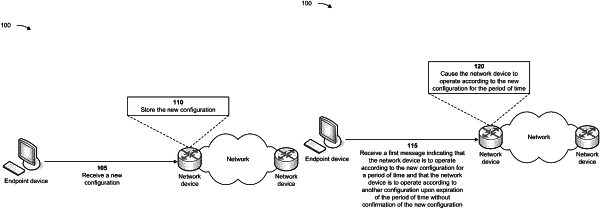| CPC H04L 41/0894 (2022.05) [H04L 41/0879 (2013.01)] | 20 Claims |

|
1. A method, comprising:
receiving, by a network device, a new configuration,
wherein the network device, when receiving the new configuration, operates according to an active configuration that is stored in a first data structure;
storing, by the network device, the new configuration in a second data structure,
wherein the second data structure includes a user specified configuration;
receiving, by the network device, a first message indicating that the network device is to operate according to the new configuration for a period of time,
wherein the first message includes at least one of:
information identifying that the network device is to operate according to the new configuration;
information identifying the period of time; or
information identifying that the network device is to operate according to the user specified configuration upon expiration of the period of time without confirmation of the new configuration;
causing, by the network device and based on the first message, the new configuration to be temporarily stored in the first data structure to cause the network device to operate according to the new configuration for the period of time;
determining, by the network device and based on causing the new configuration to be stored in the first data structure, whether the network device received, prior to expiration of the period of time, a second message indicating confirmation of the new configuration; and
selectively:
causing, by the network device, the user specified configuration to be non-temporarily stored in the first data structure to cause the network device to operate according to the user specified configuration after expiration of the period of time, based on determining that the network device did not receive the second message prior to expiration of the period of time; or
causing, by the network device, the new configuration to be non-temporarily stored in the first data structure to cause the network device to operate according to the new configuration after expiration of the period of time, based on determining that the network device received the second message prior to expiration of the period of time.
|